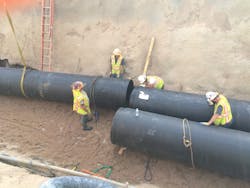HDPE pipe rehabilitates corrugated metal pipe in Boulder, Colo., storm-water system
A large corporation in the Boulder, Colo., area experienced a serious situation on its property when a pair of 48-in. elliptical corrugated metal pipes (CMP) collapsed in the immediate vicinity of many critical utilities. The pipes were located at the very end of the storm-water system that handles all of the storm water for the west side of the property. The pipes were connected to an existing concrete collection vault then ran 120 ft with the last 40 ft under an access road before discharging to an open storm-water ditch.
When the pipe collapsed, it interrupted site storm-water drainage, creating severe flooding on the property. Without a quick repair, the company was looking at significant ongoing costs for temporary measures and the possibility of severe damage to underground infrastructure systems. Part of the problem was that a section of the pipe itself ran under an existing access road that had critical utilities running through it. The prospect of digging up and replacing that section of the culvert was costly. The project team looked at the possible solutions to the complicated problem and decided to go with Snap-Tite. It uses lightweight, flexible and durable high-density polyethylene (HDPE) pipe to rehabilitate, and often outperform, corrugated metal. The project team found that HDPE has tremendous advantages over concrete and corrugate-metal replacement or repair. The Snap-Tite system segments could be “snapped” together, creating a watertight seal at all joints.
Another concern with lining the pipe was a reduction in flow rate through the pipes. The system’s joints are machined on the end of PE 3408 high-density polyethylene pipe. The result is a watertight joint whose inside and outside diameters are the same as those of the pipe.
Each of the pipes runs approximately 120 ft through the affected area. The project team was forced to excavate an area 80 ft long and 20 ft deep to remove the unsalvageable corrugated metal pipe, and the remaining 40 ft of pipe stayed under the access road. Removing the remaining 40 ft of CMP under the access road was not an option. The drainage water needed to be continuously pumped away from the site of the damage and the underground utilities. That process was costing the company upwards of $20,000 per day. This collapse needed to be fixed and fixed quickly.
Because the existing corrugated metal pipe was elliptical shaped, Snap-Tite provided oval pipe to slide into the existing pipe under the access road. A custom length of pipe was created that was ovaled only halfway. The remaining length was left the standard round and continued through the open-cut section. Contractor Thorcon mixed concrete and water to create a very flowable mix, which they then pumped into the annular space between the existing CMP and the new Snap-Tite liner pipe.
It was also very important make sure all the storm water coming from the drain in the adjacent parking lot was directed into the new HDPE pipeline.
The process was relatively simple. The contractor cut a hole in the side of the Snap-Tite at the location of the incoming concrete pipe. They then took a small length of solid wall HDPE pipe with a slightly larger ID than the OD of the concrete pipe and slid it on the concrete pipe. The contractor then matched the new piece of HDPE up to the hole on the Snap-Tite and used a process called extrusion welding to permanently attach it. This allowed all the drainage from the parking lot to now be captured and flow out to the storm-water ditch.
